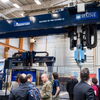Cutting edge | Investment in new equipment helps Stratton Lumber handle spikes and lulls in an increasingly competitive dimensional lumber market
With the mill's shutdown threatening to stretch into the second day, Miller scrambled to find a replacement motor, finally getting a new one operational just 24 hours after its predecessor died. By the start of the next morning's shift, operations were back to full capacity. "Plan B didn't work, so we went to plan F," Miller says. "Like any manufacturing business, we do what needs to be done."
Problems like a blown motor are facts of life at Stratton Lumber, where machinery runs full-time to debark, saw and stack millions of board feet of lumber each year. And while Miller is forced to work on the fly to fix day-to-day snags ˆ even if it means shutting down the mill for a day ˆ such problems are relatively small in scale. Of bigger importance, however, is making sure that operations at Stratton Lumber are tuned to handle a hyper-competitive market and rapid swings in economic forces that threaten to put unresponsive sawmills out of business. As a result, mills across the United States and Canada increasingly are looking for new ways to streamline ˆ and in many cases expand ˆ their operations, working to find efficiencies at every step in the process from the time raw timber enters the mill until it leaves as neatly stacked lumber.
Since 2001, Stratton Lumber has spent more than $6 million expanding its mill, adding new equipment and infrastructure to boost efficiency, including a $3 million overhaul of its planer mill ˆ which Miller estimates puts the finishing touches on 98% of the lumber that passes through Stratton ˆ that was completed in 2003. As a result of those improvements, Miller says the mill these days is able to squeeze considerably more lumber from each log.
Thanks to those infrastructure upgrades, Stratton Lumber in May extended production from five to seven days a week, and by next year Miller expects production of dimensional lumber ˆ think two-by-fours and other staples of the construction industry ˆ to reach 75 million board feet a year, a 50% increase from current production levels of roughly 50 million board feet. Meanwhile, the company earlier this year increased its workforce by 50%, adding 25 new employees to bring its total workforce to 75. "We're capitalizing on the investment we made," says Miller. "We're in a commodity business, and we have to deal on volume."
The changes in recent years at Stratton Lumber aren't unique; industry experts say most sawmills that have stayed in business in the Northeast are the ones that have been quick to make adjustments that boost efficiency, whether it's upgrading technology or modernizing manufacturing equipment. In recent years, heavy demand for construction-grade lumber ˆ primarily driven by huge growth in new residential construction ˆ has led mills such as Stratton to boost capacity. And those mills have been rewarded financially as lumber prices have risen and demand remains strong. But whether those prices will remain high is difficult to predict: Domestic real estate trends, foreign competition and environmental factors all contribute to a push-and-pull on prices in the lumber market, and those prices don't always mesh with the typical supply-and-demand curve.
The best way to handle that market volatility, according to experts, is for lumber mills to cut costs in order to produce finished lumber cheaper than their competition ˆ and to produce more of it. "Everyone's adding capacity and investing to cut costs," says Paul Jannke, vice president of wood products and timber at Resource Information Systems, a New Bedford, Mass.-based industry research firm. "They need to be competitive when the downturn comes."
Feeding the housing boom
Keeping a competitive edge in the dimensional lumber business has been the big driver behind the recent upgrades at Stratton Lumber, which Miller characterizes as a medium-sized player in the lumber market. He says Stratton's total output makes up roughly 0.2% of North America's annual production of dimensional lumber, and that there are eight or nine mills in western Maine and southeastern Quebec that he sees as direct competition. (One of those is Fontaine Inc., Stratton's sister mill in Woburn, Quebec, that's owned by Stratton Lumber's parent company, the Fontaine Group.)
Meanwhile, despite the fact that timber historically has been big business in Maine and the rest of northern New England, the region's lumber production is tiny compared with the rest of the country. According to Jeff Easterling, president of the Cumberland-based Northeastern Lumber Manufacturers Association, mills in New England produce just 500 million board feet of construction-grade lumber each year ˆ a fraction of the 16 billion board feet produced in the southern states, or the 17 billion board feet from the western United States. "You can see what a small player we are," he says.
And being a small player, according to Jannke, means more pressure to be efficient. He notes that 70% of a mill's overhead is wood costs, and mills like Stratton Lumber need ready access to cheap sources of wood to be efficient. Miller says roughly 90% of Stratton's wood comes from nearby sources in Maine, and the mill gets the rest of its wood from New England-based suppliers. (However, Miller also says his mill was hurt when timber supplies fell off last year after his suppliers ˆ half of which rely on foreign workers ˆ faced labor shortages from H2B-visa-related problems).
Still, suppliers large and small are racing to keep up with recent demand for dimensional lumber. The current housing boom has pushed new-home starts ˆ an industry term for the average number of new houses built each year ˆ to 2.08 million in the first quarter of 2005, an 8% increase from the year ago period. As a result, there's a clamor for sawmills like Stratton to keep churning out bundles of construction-grade lumber for use in everything from framing studs to floor joists.
Jannke says that sawmills across the United States and Canada have enjoyed high prices for their product thanks to that strong demand. Many mills, like Stratton, have added capacity to their facilities in hopes of taking advantage of the robust market, and mills across North America have bumped up production considerably. Jannke expects production capacity in the North American market, which reached 75 billion board feet last year, to grow by 1.3 billion board feet this year.
But while it seems like boom times in the lumber industry right now, as pricing and demand remain strong, Jannke says sawmills must watch out if demand begins to taper off and North American mills continue to produce high volumes of lumber. "Prices are going down because there's so much capacity out there, and if housing starts drop off [the impact] is going to be huge," he says. "Going forward, mills won't be making piles of money like they did in 2004."
Miller knows first hand that excess supply can wreak havoc on pricing. He cites the impact of a pine beetle outbreak a few years ago that threatened to devastate huge stands of timber in the western United States and Canada. Fearing the loss of billions of dollars worth of softwood production, U.S. and Canadian officials called on timber companies to start cutting trees before they were lost to infestation, according to Miller. The result: A glut of cut timber that dramatically pushed down lumber prices and kept them low until as recently as last year. Miller says he saw prices drop as much as 30% in just a few months' time. "Most of the mills in the eastern U.S. were producing at break-even when prices were depressed," he says. "That's all they could do. There were mills going out of business because of that."
And if the housing market cools and prices begin to fall, Miller expects mills to have a harder time finding buyers for all the lumber they're now producing. "We'd be scrambling and it will be dog-eat-dog," he says. "Whoever's got the lowest cost structure will survive."
Better eyes, better machines
To that end, Stratton Lumber during the past few years has spent millions updating and modernizing its equipment. But while many of the big-ticket items have helped streamline operations ˆ Miller says the roughly $3 million spent to upgrade the planer mill has tripled the mill's total production capacity ˆ the biggest boosts to the mill's efficiency have been in technology.
In the early 1990s, the mill first invested in optimization and scanning software ˆ as well as a range of electronic eyes attached to cutting machines ˆ that offers highly accurate predictions of how a piece of raw timber can be used most efficiently. Thanks to the ability to map a log three-dimensionally, the program might recommend, for example, rotating a piece of lumber a certain direction before it goes through the saw. That small adjustment might yield a few more two-by-fours and two-by-sixes than if the log remained in its original position. "Before the software, it was all human decisions," says Petr Smetanka, chief operating officer of the Fontaine Group and co-owner of Stratton Lumber. "Even the best operators cannot make the mental calculations that a computer can make."
Smetanka says that nearly every piece of equipment at Stratton Lumber is connected in some way to the optimization software, which has been continually updated over the years. Miller estimates that these days the mill can get 10%-15% more usable lumber from each log than it did in the early 1990s. "We need to keep updating [the software] all the time if we want to stay competitive," says Smetanka. "The mills that will be around five years down the road will use these systems, or else they won't be competitive."
In order to stay competitive, Stratton Lumber also gets info the old-fashioned way. Random Lengths, an industry newsletter published in Eugene, Ore., publishes weekly data detailing lumber pricing and demand for the North American market. "It lets us know what customers are going to need over the next few weeks or months," says Miller.
Those insights help the mill avoid overproducing lumber. Stacks of two-by-fours can only sit for so long before sucking up warp-inducing moisture, so Miller needs to get the wood out the door as fast as he can. Using that weekly market information allows the crews at Stratton Lumber to program the optimization and scanning software to produce what's needed ˆ whether it's 16-foot two-by-fours or 12-foot two-by-eights ˆ while limiting the amount of waste during the manufacturing process. "Technology keeps mills able to stay efficient and produce a product that's going to be accepted in the marketplace," says NELMA's Easterling. "They can get the very best and most of out each log, and anyone dealing with a construction commodity has to make sure they squeeze the most product out that they can."
And if coming price volatility and gyrations in demand breed increased competition in the lumber market, Miller says keeping on the industry's cutting edge is the best way for Stratton Lumber to remain profitable. With the addition of 25 new employees in May, Miller says the mill's two kilns have become a "choke point," a bottleneck where finished lumber waits to be dried to industry specifications. To smooth out production, the company has ordered a new, $1 million drying kiln that can handle 175,000 board feet of lumber. Miller expects to have the new kiln operational by the end of the year.
"That's our insurance policy," he says. "That's why we don't dare let up. In our world, if a company invests in all new technology, they could leapfrog our capability. Then they'd have the strategic advantage."










Comments